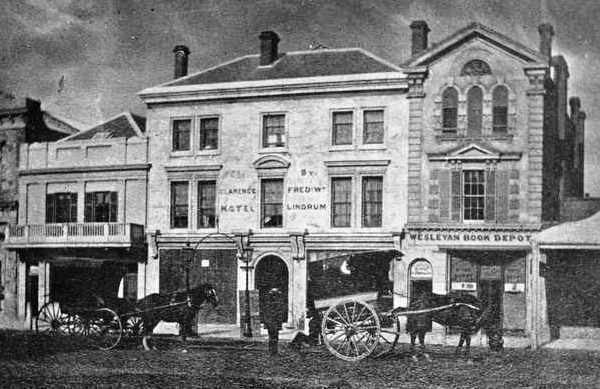 | ||
White's Rooms, later known as Adelaide Assembly Room, was a privately owned function centre which opened in 1856 on King William Street, Adelaide. It became Garner's Theatre in 1880, then passed through several, hands being known as the Tivoli theatre, Bijou theatre, Star picture theatre and finally in 1916 the Majestic Theatre and Hotel.
Contents
History
George White (1813 – 12 November 1876) was a Gloucestershire tailor who emigrated with his family to South Australia on the Royal Admiral, arriving in Adelaide in January 1838. He set up a tailoring business in Hindley Street, then took up a position with William Pearce in Rundle Street. Pearce quit the business in May 1843, and White purchased much of his stock, and around 1852 moved to larger premises in King William Street (which later became the public bar of the Clarence Hotel). His Assembly Rooms were opened on 26 June 1856 with a Grand Masonic Ball, and were for many years the only place of public entertainment in the city.
In 1878 Thomas Waterhouse purchased the property from George White's estate, and it remained in that family for many decades.
The rooms
The building at 80–88 King William Street was designed by George Kingston. Its Assembly Room was 41 by 86 feet (12 m × 26 m) with a 30-foot-high (9.1 m) ceiling, and the complex included offices, retail business spaces and an Arbitration Room, where daytime auction sales, meetings, and other gatherings were held, and was co-located with the Clarence Hotel.
The place was remodelled several times to keep abreast of the competition, (one major upgrade was superintended by E. J. Woods)
The restaurant
Below the main hall, founded in 1856 and attached to the Clarence Hotel, was Bayston & Aldridge's restaurant, from November 1858 solely managed by George Aldridge. It was here that John McDouall Stuart was given a grand reception, presided by Sir Dominic Daly, on the evening of 21 January 1863, on his return from crossing the continent from south to north. Then in 1868 Aldridge left to take over the restaurant associated with the new theatre in Hindley Street, and F. W. Lindrum, father of Frederick and Walter Lindrum, took it over, naming it "Shades" or "Adelaide Shades". One of the large underground halls was set up by him as a billiard saloon, the finest in the city.
Subsequent history
In 1880 White's Rooms was remodelled by George Gordon to become Garner's Theatre, for entrepreneur Arthur Garner and Wybert Reeve the theatre manager. It was not entirely successful, and T. P. Hudson took over the lease, who after more redecoration reopened the theatre as The Bijou. Among its users between 1890 and 1899 was the Garrick Club theatre group.
Harry Rickards became the next proprietor in 1900, demolishing much of the old structure and renaming it The Tivoli. It closed in August 1913 to reopen as the New Tivoli Theatre in Grote Street. Bud Atkinson promptly took over the lease and in September 1913 it became the Star Theatre, a cinema screening a one-hour programme continuously from 11 am to 10.30 pm daily. It closed in November 1915, but was the start of a chain of movie theatres.
In 1916 the building, and the Clarence Hotel, were demolished to become the Majestic Theatre and hotel. In 1928 Sir Benjamin Fuller, John Fuller and Bert Lennon purchased the theatre from the owners A. E. and F. Tolley.
Some notable uses and users
Reports that Adelaide City Council meetings were held there during construction of the Town Hall, are spurious.
Family
George White (1813 – 12 November 1876) married Eliza Baxter (1814 – 16 August 1888) in Gloucestershire on 24 November 1834; with children Charles and Jane emigrated to South Australia on the Royal Admiral, which arrived in South Australia in January 1838.
George was a keen gardener and viticulturist: his vineyard and magnificent formal garden later became the suburb of Rosefield.
